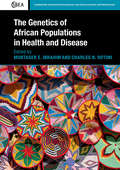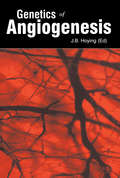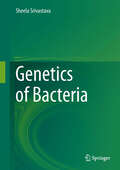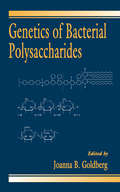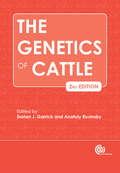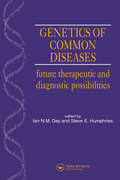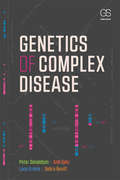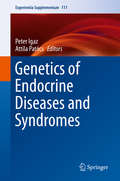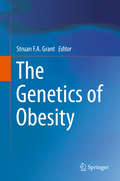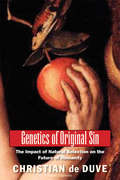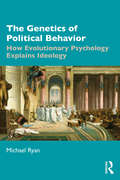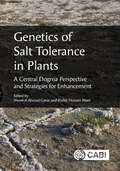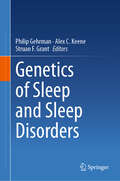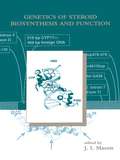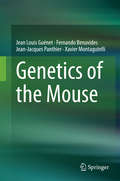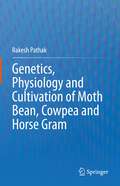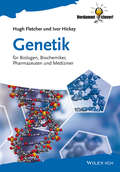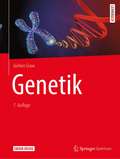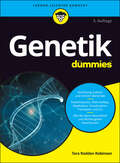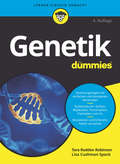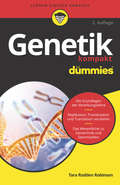- Table View
- List View
The Genetics of African Populations in Health and Disease (Cambridge Studies in Biological and Evolutionary Anthropology #84)
by Muntaser E. Ibrahim Charles N. RotimiThe birthplace of modern humans, Africa, has the highest genetic diversity in the world, yet it remains vastly understudied. With biomedical research increasingly focused on human variation, studying the large population size and number of mutations in African genomes could unravel the complexity of phenotypic traits underlying the biology of our species and hold huge potential for scientific and medical advances. An initial chapter 'conceptualizes Africa', providing relevant terminology. The first section covers genetic history and population structure. The next section looks at the genetic basis of common infectious diseases, such as leishmaniasis, malaria and tuberculosis, with a final part considering common non-communicable diseases, such as diabetes, hypertension, obesity, heart disease and cancer. Gene environment interaction under globalization and the burden of diseases of lifestyle are included. For researchers and graduate students in biological anthropology, genetic anthropology, human and population genetics, and public health.
Genetics of Angiogenesis
by James HoyingAngiogenesis research is one of the most quickly developing areas in biomedicine. It is considered to be a common denominator in society's most important diseases and pharmaceutical companies are racing to develop new angiogenesis-based drugs.This volume focuses on the genetic control of angiogenesis, both in humans and model organisms, and will be a valuable resource to all researchers in the field, including the fundamentals of the process as well as workers in biotechnology.
Genetics of Bacteria
by Sheela SrivastavaDescribed as the earliest, simplest life forms, with unlimited metabolic versatility, bacteria are ideally suited to answer some very fundamental questions on life and its processes. They have been employed in almost all fields of biological studies, including Genetics. The whole edifice of science of Genetics centers around three processes: the generation, expression, and transmission of biological variation, and bacteria offer immediate advantages in studying all the three aspects of heredity. Being haploid and structurally simple, it becomes easy to isolate mutations of various kinds and relate them to a function. The availability of such mutants and their detailed genetic and biochemical analyses lead to a gamut of information on gene expression and its regulation. While studying the transmission of biological variation, it is clear that unlike their eukaryotic counterpart, a more genetic approach needs to be employed. Transmission of genetic information in most eukaryotic organisms rests on sexual reproduction that allows the generation of genetically variable offspring through the process of gene recombination. Even though bacteria show an apparent preference for asexual reproduction, they too have evolved mechanisms to trade their genetic material. In fact, bacteria not only could acquire many genes from close relatives, but also from entirely distant members through the process of horizontal gene transfer. Their success story of long evolutionary existence will stand testimony to these mechanisms. While teaching a course on Microbial Genetics to the post-graduate students at Delhi University, it was realized that a book devoted to bacterial genetics may be very handy to the students, researchers, and teachers alike. A strong foundation in genetics also helps in comprehending more modern concepts of molecular biology and recombinant DNA technology, always a favorite with the students and researchers. Planning the format of the book, emphasis has been laid on the generation and transmission of biological variability. The omission of expression part is indeed intentional because lots of information is available on this aspect in any modern biology book. The contents are spread over seven chapters and the text is supported with figures/tables wherever possible. The endeavor has been to induce the readers to appreciate the strength of bacterial genetics and realize the contribution of these tiny organisms to the growth of biological sciences as a whole and genetics in particular.
Genetics of Bacterial Polysaccharides
by Joanna B. GoldbergBacterial surface or secreted polysaccharides are molecules that can function as barriers to protect bacterial cells against environmental stresses, as well as act as adhesins or recognition molecules. In some cases, these molecules are immunodominant antigens eliciting a vigorous immune response, while in other cases the expression of polysacchari
Genetics of Cattle, The
by Dorian J. Garrick Anatoly RuvinskySince the time of domestication more than 10,000 years ago, cattle have played an increasingly crucial role in the development of human civilizations. Progress has been quite remarkable since the turn of the century; the sequencing of the bovine genome in 2009 launched new avenues for furthering our understanding of theoretical and practical aspects of cattle genetics. Covering a vast array of questions, this book reviews major topics from molecular and developmental genetics, disease resistance and immunogenetics to genetic improvement of dairy and beef breeds, addressing all current problems in the field. This second edition includes a new team of authors and completely new chapters on the genetics of fat production, nutrition, feed intake and efficiency, growth and body composition. Fully updated throughout, it provides a valuable resource on cattle genetics for researchers, breeders, veterinarians and postgraduate students.
Genetics of Common Diseases: Future Therapeutic and Diagnostic Possibilities
by Ian N.M. Day and Steve E. HumphriesMany common diseases are partly attributable to the genes which an individual inherits. Early steps have now been made in developing ways to determine which genetic variations are important, with some recent successes. This is a collection of papers from the Fifth Annual Molecular Pathology Symposium on the 10 December 1996. They represent the contributions to that meeting made by a set of distinguished scientists and clinicians whose work pertains to the furtherment of our understanding of the genetic components of common diseases and potential future approaches.
Genetics of Complex Disease
by Peter Donaldson Ann Daly Luca Ermini Debra BevittGenetics of Complex Disease is a concise text for final year undergraduate and first year graduate students. Healthcare professionals and other biomedical scientists trying to come to grips with the impact of new genetics research will also find the book useful. After explaining genetic variation and defining complex diseases, the text shows how and why complex diseases are investigated. The focus then changes to areas where there is strong evidence for the genes/alleles involved. Important ethical consequences are also covered, as are the methods used to generate new genetic data.
Genetics of Endocrine Diseases and Syndromes (Experientia Supplementum #111)
by Peter Igaz Attila PatócsThis book provides a comprehensive overview of the genetic basis underlying endocrine diseases. It covers both the molecular and clinical consequences of these genetic defects, as well as the relevance for clinical care, highlighting issues of genetic counseling. Several endocrine diseases have a genetic background, and contemporary research in the field plays a crucial role in the clinical care of endocrine diseases. In recent years, there have been major developments in our understanding of the genetic basis of endocrine diseases. Several novel genes and mutations predisposing individuals to monogenic endocrine diseases have been discovered, and with the advent of next generation sequencing, a huge amount of new data has become available. Further, novel molecular mechanisms, such as genomic imprinting, have been implicated in the pathogenesis of endocrine diseases.A better understanding of the genetic background of these diseases is relevant not only from the research perspective, but also in terms of clinical care. As such, this book is an essential read for both researchers and clinicians working in the field.
Genetics of Mental Disorders: What Practitioners and Students Need to Know
by Stephen V. Faraone Ming T. Tsuang Debby W. TangIntroduces ideas about inherited genetically based mental disorders and how they combine with environmental factors. thinks about mental disorders with insight.
The Genetics of Obesity
by Struan F.A. GrantIn the past four years, many genetic loci have been implicated for BMI from the outcomes of genome-wide association studies (GWAS), primarily in adults. Insulin-induced gene 2 (INSIG2) was the first locus to be reported by this method to have a role in obesity but replication attempts have yielded inconsistent outcomes. The identification of the second locus, the fat mass- and obesity-associated gene (FTO), h has been more robustly observed by others. Studies from both FTO knock out and FTO overexpression mouse model support the fact that FTO is directly involved in the regulation of energy intake and metabolism in mice, where the lack of FTO expression leads to leanness while enhanced expression of FTO leads to obesity. Along with numerous other studies, a number of genetic variants have been established robustly in the context of obesity, giving us fresh insights into the pathogenesis of the disease. This book will give a comprehensive overview of efforts aimed at uncovering genetic variants associated with obesity, which have been particularly successful in the past 5 years with the advent of genome-wide association studies (GWAS). This book will cover this state of the art technology and its application to obesity in great detail. Topics covered will include genetics of childhood obesity, genetics of syndromic obesity, copy number variants and extreme obesity, co-morbidities of obesity genetics, and functional follow-up of genetic variants.
Genetics of Original Sin: The Impact of Natural Selection on the Future of Humanity
by Christian De Duve Neil PattersonIncreasingly absorbed in recent years by advances in our understanding of the origin of life, evolutionary history, and the advent of humankind, eminent biologist Christian de Duve of late has also pondered deeply the future of life on this planet. He speaks to readers with or without a scientific background, offering new perspectives on the threat posed by humanity's immense biological success and on the resources human beings have for altering their current destructive path. Focusing on the process of natural selection, de Duve explores the inordinate and now dangerous rise of humankind. His explanation for this self-defeating success lies in the process of natural selection, which favors traits that are immediately useful, regardless of later consequences. Thus, the human genome determines such properties as tribal and group cohesion and collaboration and often fierce and irrational competition with and hostility toward other groups' attributes that were once useful but now often ruinously dysfunctional. Christian de Duve suggests that these traits, imprinted into human nature by natural selection, may have been recognized by the writers of Genesis, thus inspiring the myth of original sin. Is there redemption for genetic original sin? In a brilliant and original conclusion, the author argues that, unique in the living world, humankind is endowed with the ability to deliberately oppose natural selection. Human beings have the capacity to devise measures that, while contrary to local or personal interests, can bring forth a safer world.
The Genetics of Political Behavior: How Evolutionary Psychology Explains Ideology
by Michael RyanIn this unique amalgam of neuroscience, genetics, and evolutionary psychology, Ryan argues that leftists and rightists are biologically distinct versions of the human species that came into being at different moments in human evolution. The book argues that the varying requirements of survival at different points in history explain why leftists and rightists have anatomically different brains as well as radically distinct behavioral traits. Rightist traits such as callousness and fearfulness emerged early in evolution when violence was pervasive in human life and survival depended on the fearful anticipation of danger. Leftist traits such as pro-sociality and empathy emerged later as environmental adversity made it necessary for humans to live in larger social groups that required new adaptive behavior. The book also explores new evolutionary theories that emphasize the role of the environment in shaping not only human political behavior but also humans' genetic architecture. With implications for the future of politics, the book explores how the niche worlds we build for ourselves through political action can have consequences for the evolution of the species. Proposing a new way of understanding human politics, this is fascinating reading for students and academics in psychology, the social sciences, and humanities, as well as general readers interested in political behavior.
Genetics of Salt Tolerance in Plants: A Central Dogma Perspective and Strategies for Enhancement
by Kehinde A. Adeboye Victor J. Bamisaye Farwa Basit Usman Rabi’u Bello Javaid Akhter Bhat Jamindar Buddiga Utpal Das Balasundari Dharbaranyam Xianzhong Feng M. Gayathri Abubakar Mohammad Gumi Md Sazzad Hossain Emmanuel O. Idehen Krishnananda P. Ingle Nancy McMulkin Mushtaq Ahmad Najar Oyeboade A. Oyetunde Kapil Patil Britta Pitann Shiva Sai Prasad Fergie Ann Quilloy Md Zillur Rahman J. R. Rajeshwar P. W. Ramteke Hamza Ramzan Vincent Pamugas Reyes Kausalya Sakthivel Palanisamy Senthilmurugan Usama Sheraz Sajid Shokat Pradeep Kumar Shukla Atul Singh Gayatri Venkataraman Mst Ishrat ZahanGene expression in cells follows a prescribed pathway that conforms to the Central Dogma; where the genetic information stored in DNA is transcribed into RNA and then expressed into proteins, which influences most plant traits. Plant salt tolerance research is directed towards identifying nucleotide variants that could contribute to tolerant phenotypes. This book comprehensively presents the current state of knowledge on plant salt tolerance through meticulous analysis of the processes operating across the Central Dogma. It provides a detailed account of modulation of gene expression through genome editing systems to achieve crop improvement against salt stress. It also provides state-of-the-art information on advances in breeding technologies of genome selection and accelerated de novo domestication for rapidly improving the salt tolerance of plants for global food security. This book: 1.Provides a comprehensive coverage of plant salt tolerance mechanisms. 2.Spotlights various factors functioning along the Central Dogma pathway and their regulation in response to salinity. 3.Examines how these factors function to protect the plants from high salinity. 4.Highlights advances in cutting-edge breeding technologies for improving salt tolerance. The book will be of particular value to students and researchers of plant genetics, molecular biology and physiology and those with an interest in salinity and salt tolerance.
Genetics of Sleep and Sleep Disorders
by Philip Gehrman Alex C. Keene Struan F. GrantThis book focuses on the latest research on the genetic basis of the regulation of sleep and wakefulness and of sleep and circadian rhythm disorders, which has been expanding rapidly due to advances in genetics. The book reviews the latest genetic discoveries in animals and humans and explores their implications for getting a good night's sleep. Philp Gehrman, Alex Keene, Struan Grant, and a cadre of top sleep researchers and clinicians explore the genetics of sleep and sleep disorders in depth. The book should appeal to sleep medicine specialists, psychiatrists, geneticists, and neuroscientists.
Genetics of Steroid Biosynthesis and Function (Modern Genetics Ser.)
by J. I. MasonSteroids are among the most widely prescribed drugs for humans, and steroid signaling pathways are present in vertebrates, plants, insects and fungi, presenting new avenues for biotechnological intervention. Genetics of Steroid Biosynthesis and Function focuses on the genetic and cellular aspects of mammalian steroid hormones with particular attent
Genetics of the Mouse
by Jean Louis Guénet Fernando Benavides Jean-Jacques Panthier Xavier MontagutelliThis book, written by experienced geneticists, covers topics ranging from the natural history of the mouse species, its handling and reproduction in the laboratory, and its classical genetics and cytogenetics, to modern issues including the analysis of the transcriptome, the parental imprinting and X-chromosome inactivation. The strategies for creating all sorts of mutations, either by genetic engineering or by using mutagens, are also reviewed and discussed in detail. Finally, a last chapter outlines the methodology used for the analysis of complex or quantitative traits. The authors also discuss the importance of accurate phenotyping, which is now performed in the mouse clinics established worldwide and identify the limits of the mouse model, which under certain circumstances can fail to present the phenotype expected from the cognate condition in the human model. For each chapter an up-to-date list of pertinent references is provided. In short, this book offers an essential resource for all scientists who use or plan to use mice in their research.
Genetics, Physiology and Cultivation of Moth Bean, Cowpea and Horse Gram
by Rakesh PathakThis authored book gives insight into the morphology, physiology, genetics, plant protection and biotechnology of three important arid legumes, viz., moth bean, cowpea and horse gram. There are seven chapters for each crop that provide in-depth information on cultivation, genetic improvement, plant protection measures, management of physiological and abiotic stresses along with related genetic markers and biotechnological advances pertaining to these legumes. The chapters present research findings and brief reviews concerning the advances made in the improvement of these legumes.Legumes are utilized as pulses or grains aiding as an important source of protein for both human and animal consumption and also provide raw materials to the food and feed industries. They are also valuable for soil building, improving soil quality and biological nitrogen fixation. Physiology and genetics provide an inimitable source of information on the distinct aspects of basic and applied legume research for general readers, students, academicians and researchers. Arid legumes are crops characterized by inherent features and capabilities to withstand adverse and harsh climatic conditions, significantly replenish the soil, as well as provide protein and micronutrients. Adaptability to several stresses including drought makes them key to agriculture in areas receiving scanty rainfall. This comprehensive book disseminates significant information on the genetic diversity, cultivation, manipulation through mutagenic techniques, molecular biology and other breeding techniques. The book, therefore, is of importance to teachers, researchers and policymakers who are interested to acquire knowledge about moth bean, cowpea and horse gram. It also serves as an additional reading material for MSc and PhD students of agriculture and environmental sciences. The book is also useful to national and international agricultural scientists and policymakers.
Genetik: für Biologen, Biochemiker, Pharmazeuten und Mediziner (Verdammt clever!)
by Hugh Fletcher Ivor Hickey Claudia HorstmannKompakt und »verdammt clever« auf den Punkt gebracht – vermittelt Genetik das unverzichtbare molekulare Grundwissen sowie alles Wichtige zu den Themen Genome, Mechanismen der Vererbung, Humangenetik, Populationsgenetik und Evolution sowie zu den Anwendungen der modernen Genetik. Das ideale Einsteiger-Buch – verständlicher Text, einprägsame Abbildungen und präzise Kapitelzusammenfassungen sind echte Pluspunkte, wenn es um einen schnellen Start in dieses spannende Fach geht. • Das perfekte Kurzlehrbuch! Optimal für eine Einführung in die molekulare Genetik – die wirklich wichtigen Themen werden mit ihren Kernaussagen kurz und knapp behandelt. • Verständliche Darstellung! Jedes Kapitel enthält eine Zusammenfassung der wesentlichen Fakten und Begriffe, klare und leicht erfassbare Abbildungen illustrieren die Inhalte. • Ohne Angst in die Prüfung! Der Textaufbau ermöglicht strukturiertes Lernen und schnelles Wiederholen – zusätzlich mit über 70 Fragen und Antworten zum Üben.
Genetik
by Jochen GrawVon Mendel bis zu Genomforschung und Gentechnologie reicht dieses Standardwerk der Genetik. Es ist klar strukturiert und bietet eine umfassende Darstellung der klassischen und der molekularen Genetik. Cytogenetik, Entwicklungsgenetik, Humangenetik und Anthropologie sowie Neuro- und Verhaltensgenetik sind weitere wichtige Inhalte. Komplexe Sachverhalte werden verständlich und auf dem aktuellen wissenschaftlichen Stand dargestellt. Technikboxen bereichern das umfassende Themen- und Methodenspektrum. Dieses Buch vermittelt genetisches Grundlagenwissen für das gesamte Studium. Dabei unterstützen zahlreiche hervorgehobene Lernhilfen und Beispiele aus allen Bereichen der Genetik, ansprechende, farbige Abbildungen sowie Übungsfragen. Die 7. Auflage wurde gründlich überarbeitet und aktualisiert sowie mit Links zu erklärenden Videos zu besonderen Aspekten des jeweiligen Kapitels ergänzt.
Genetik für Dummies (Für Dummies)
by Tara Rodden RobinsonDie Genetik ist eine der Naturwissenschaften, deren Wissen am schnellsten wächst und deren Erkenntnisse ständig in Bewegung und in der Diskussion sind. "Genetik für Dummies" erklärt, was überhaupt hinter diesem spannenden Thema steckt. Die Autorin Tara Rodden Robinson erklärt die Grundlagen der Vererbungslehre wie die Mendelschen Regeln, wie Zellen aufgebaut sind und sie sich teilen. Sie zeigt, wie die DNA aufgebaut ist, wie sie kopiert und richtig in Proteine übersetzt wird. Außerdem geht sie auf die Bedeutung der Genetik in der Humanmedizin ein, wie Genmutationen und Erbkrankheiten entstehen. Sie erläutert, was beim Klonen passiert und was sich überhaupt hinter dem Begriff Gentechnik verbirgt. Auch die heißen Themen wie Stammzellentherapie und der Einsatz der Genetik in der Rechtsmedizin werden behandelt.
Genetik für Dummies (Für Dummies)
by Tara Rodden Robinson Lisa SpockDie Genetik ist eines der naturwissenschaftlichen Fachgebiete, deren Wissen am schnellsten wächst und deren Erkenntnisse ständig in Bewegung und in der Diskussion sind. "Genetik für Dummies" erklärt, was überhaupt hinter diesem spannenden Thema steckt. Die Autorinnen Tara Rodden Robinson und Lisa J. Spock erklären einfach und prägnant die Grundlagen der Vererbungslehre, wie beispielsweise die Mendelschen Regeln und die Zellteilung. Sie zeigen auch, wie die DNA aufgebaut ist, wie sie kopiert und richtig in Proteine übersetzt wird. Außerdem gehen sie auf die Bedeutung der Genetik in der Humanmedizin ein, wie Genmutationen entstehen und Erbkrankheiten zur Folge haben. Auch die heißen Themen wie Gentechnik, Stammzellentherapie und der Einsatz der Genetik in der Rechtsmedizin kommen nicht zu kurz.
Genetik kompakt für Dummies (Für Dummies)
by Tara Rodden RobinsonSie suchen einen schnellen und leicht verständlichen Einstieg in die Genetik? Dann ist dieses Buch genau das richtige für Sie! Tara Rodden Robinson erklärt Ihnen die wichtigsten Grundlagen der Vererbungslehre: Wie die DNA aufgebaut ist, wie sie kopiert und richtig in Proteine übersetzt wird, was es mit den Mendelschen Regeln auf sich hat, wozu Gentechnik gut ist, wie Genmutationen und Erbkrankheiten entstehen und vieles mehr. So ist dies Ihr perfekter Nachhilfelehrer für die Tasche: verständlich, kompetent, günstig.
Genetik kompakt für Dummies (Für Dummies)
by Tara Rodden RobinsonAuf einen Blick: Die Grundlagen der Vererbungslehre Alles Wichtige zu DNA, RNA, Mutationen und Co. Die Mechanismen der Replikation, Transkription und Translation Das Wesentliche zu Gentechnik, Stammzellen und mehr Ihr Speed-Date mit der Genetik Der schnelle Überblick für Schüler, Studenten und jeden, den es sonst noch interessiert Sie suchen einen kompakten und leicht verständlichen Einstieg in die Genetik? Dann ist dieses Buch genau das richtige für Sie! Es enthält das Wichtigste, das Sie zur Vererbungslehre und ihren Gesetzen wissen müssen. Tara Rodden Robinson erklärt Ihnen, wie die DNA auf - gebaut ist und wie sie kopiert und richtig in Proteine übersetzt wird. Sie erfahren außerdem, was es mit den Mendelschen Regeln, Klonen und Gentechnik auf sich hat, wie Genmutationen und Erbkrankheiten entstehen und vieles mehr. So ist dies Ihr perfekter Nachhilfelehrer für die Tasche: freundlich, kompetent und günstig.
Genetik und Molekularbiologie (Kompaktwissen Biologie)
by Olaf G. SchmidtDer Espresso unter den LehrbüchernKompaktwissen Genetik und Molekularbiologie präsentiert die Inhalte in klarer, prägnanter Darstellung. Ohne unnötigen Ballast und im richtigen Kontext erläutert der Band verständlich die Fakten, Zusammenhänge und Prinzipien dieses wichtigen Teilgebiets der Lebenswissenschaften. Damit eignet er sich besonders… zur Nachbereitung von Vorlesungen und Seminaren … zur Vorbereitung auf Prüfungen… zum Nachschlagen während des späteren Studiums oder im Berufsleben. Das Wichtigste zur Genetik und ihrer Molekularbiologie von Pro- und Eukaryoten Das gesamte Wissen zur Genetik für die Prüfungen bis zum Bachelor oder ersten Staatsexamen in kompakter Form:Das genetische MaterialOrganisation des ErbgutsDNA-ReplikationTranskription und Translation bei Bakterien, Archaeen und EukaryotenRegulation der Genexpression bei ProkaryotenRegulation der Genexpression bei EukaryotenFormale Genetik, Klassische GenetikRekombination, VariabilitätKonjugation, Transduktion, Transformation bei BakterienMutationenDNA-ReparaturmechanismenHumangenetikImmun- und EntwicklungsgenetikGenomikMethoden: von DNA-Isolierung bis Genome Editing und Organ-ChipsModellorganismenDie zweite Auflage wurde durchgehend überarbeitet und um aktuelle Inhalte ergänzt. Erweitert wurden vor allem die Darstellungen zur Architektur des Genoms, seiner Kontrolle und Regulation und die Bedeutung epigenetischer Vorgänge.
Geniale Frauen in der Wissenschaft: Versteckte Beiträge, die die Welt verändert haben
by Lars JaegerObwohl Frauen schon früh das wissenschaftliche Denken mitgeprägt haben, sichtbar geworden sind sie fast nie. Dieses Ungleichgewicht setzt sich bis heute fort, auch wenn es aktuell weit mehr Wissenschaftlerinnen gibt als jemals zuvor. Lars Jaeger spannt einen Bogen von der Antike bis heute und porträtiert in essayartigen Einführungen das Leben und Wirken der wohl bedeutendsten weiblichen Naturwissenschaftlerinnen und Mathematikerinnen. Von Hypatia von Alexandria über Émilie du Châtelet und Emmy Noether bis hin zu Lisa Randall, sie alle haben Großes geleistet, die Wissenschaft entscheidend vorangebracht und konnten dennoch oft nicht aus dem Schatten ihrer männlichen Kollegen treten.Neben den spannenden Porträts der einzelnen Wissenschaftlerinnen sowie einer detaillierten und anschaulichen Darstellung ihrer wissenschaftlichen Leistungen beleuchtet dieses Sachbuch auch das Geschlechterverhältnis in der Wissenschaft, das sich nur quälend langsam zugunsten eines fairen Verhältnisses für die Frauen entwickelt.
